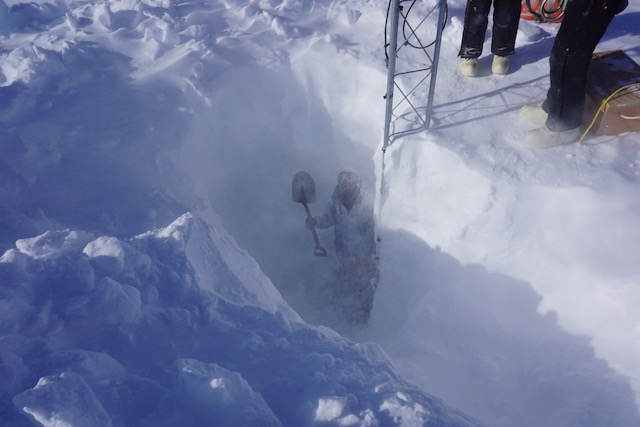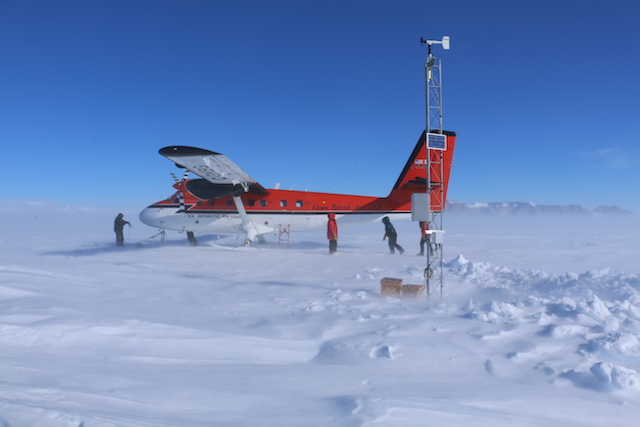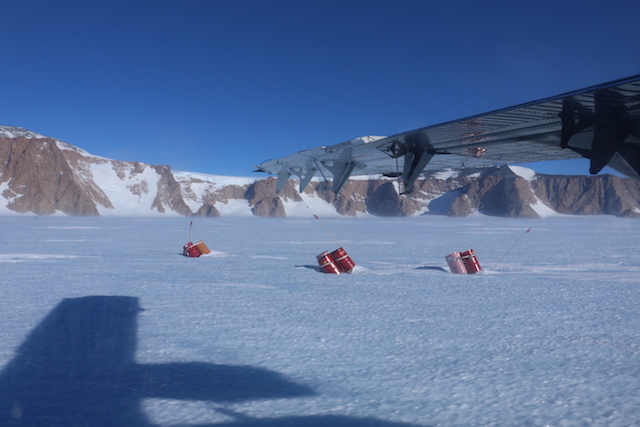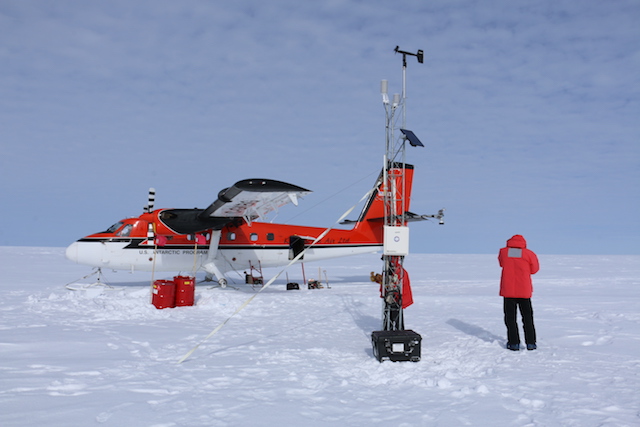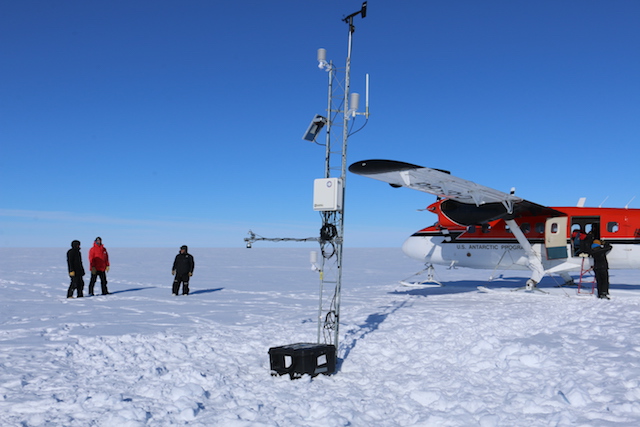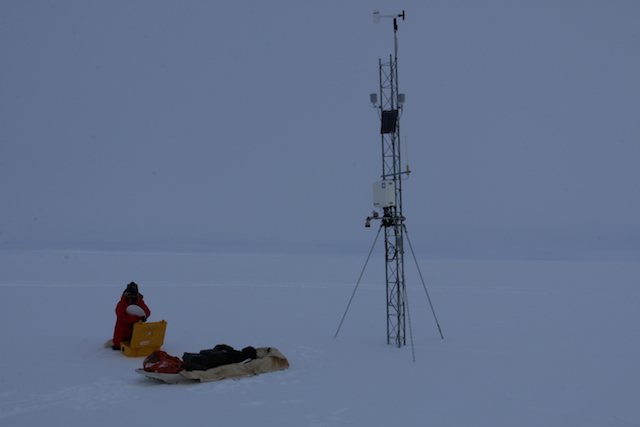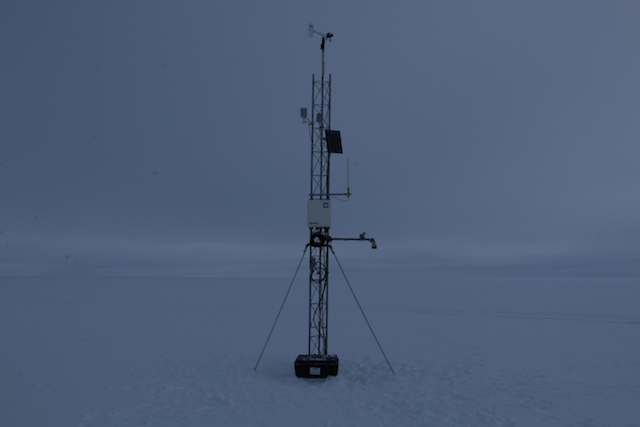In our last 5 working days at WAIS, from 17 through 21 January, Elina and I visited the remaining 5 AWS on our list. It was a whirlwind of work, and timing was perfect for us to catch our Herc flight back to McMurdo on 22 January. But first, the site visits…
On 17 January, we went to Theresa and Erin. The plan was to go to Theresa first, then refuel at a fuel cache at the Ohio Range near Theresa. After that, we would go to Erin, then go to Fallone Nunatak nearby where POLENET has a seismic and GPS site. As such, two POLENETters, Andrew and Aurora, came along for the ride.
The weather conditions at Theresa and Erin were far and away the most challenging that Elina and I experienced this field season, especially at Theresa. Theresa and Erin are located south of WAIS camp, near the Transantarctic Mountains. They are near the beginning of the Ross Air Stream, which is a wind regime where strong winds are concentrated near the Transantarctic Mountains and flow parallel to them and to the north. Skies were clear on this particular day, but it was very windy at the surface. When we arrived at Theresa, the temperature was around -4 F (-20 C) and winds were around 30 knots and increased to around 35 knots throughout the visit.

Theresa upon arrival. Notice the “soft” horizon; that’s blowing snow, an indication of how windy it was.
Notice in the picture that the battery box(es) are buried. I could not find a record of when the battery boxes were last at the surface, so I had no idea how far we would have to dig for them. Regardless, while Elina and I did work on the tower, the others were digging exuberantly to recover the batteries. After Elina and I measured the instrument heights above the surface, we removed the instrument boom so we could attach a new tower section on top.

Elina and I on the tower, just after we put a new section on. Our digging crew was already making great progress.
The batteries were buried about 8 to 10 feet! It’s so awesome that they were able to recover them. The Antarctic environment thanks us.
Next stop: the Ohio Range fuel cache, about a 20-minute flight away. This fuel cache is in a “blue ice” area, which means that winds are so high here that there isn’t much of any snow accumulation throughout the year. It all gets blown away, exposing ice that appears blue because any accumulated snow has been compressed so much that air bubbles are squeezed out and ice crystals become enlarged.
After the Otter was nice and full with fuel, we headed over to Erin, about a 45-minute light away. The Transantarctic Mountains are also visible from Erin, though we weren’t quite as close to them as at Theresa or the Ohio Range. Erin doesn’t get much accumulation, so all we needed to do here was swap out the data card in the CR1000 data logger, dig up the power system (buried about 2 feet), and raise the enclosure and lower temperature sensor on the tower. It was still windy at Erin, but not as much as at Theresa. Winds were around 20 knots when we landed, and it was slightly warmer at around 5 F (-15 C).
We were on the ground for about an hour. Then it was time to head over to POLENET’s site at Fallone Nunatak. A nunatak is a land feature, typically a mountain, then has exposed rock amongst a field of snow or ice.
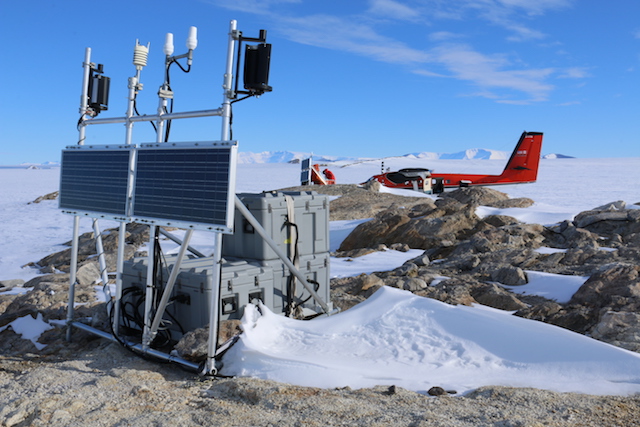
The power system for the GPS system is in the foreground, with Andrew and Aurora servicing the seismic instrumentation in the background.
The weather was much nicer at Fallone Nunatak, with relatively light winds and temperatures around 20 F (-7 C). It was like being at the beach!
After about an hour, they were done with their work and we were ready to head back to WAIS. It was another long but productive day of field work. Two days later, we had yet another very productive day, though not quite as long…
On 19 January, Elina and I flew to Harry and Elizabeth. Joining us on this trip were Scott Deaton (WAIS physician’s assistant) and Nick Chisari (WAIS cargo). We wanted to swap out the pressure sensor at Harry and raise Elizabeth. These two site visits were pretty straightforward.
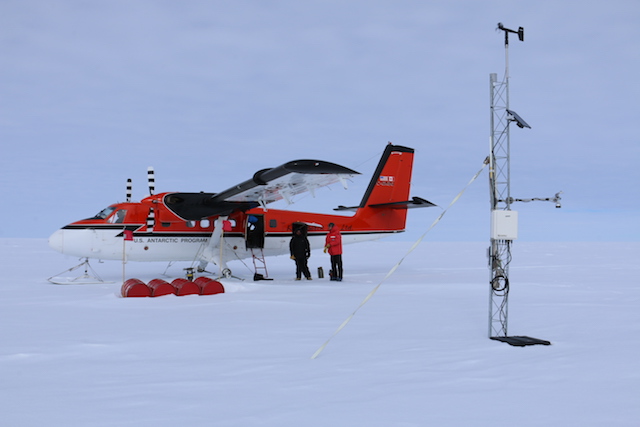
Harry upon arrival. The pilots had cached fuel there earlier in the season, hence the red drums in the background.

Elina carried through a task of highest import, placing an AWS sticker on the enclosure and thereby signifying UW-Madison’s claim to Harry AWS.
Next, we flew to Elizabeth to add a new tower section and raise the power system.
The power system was buried about 4 feet down, which is nothing! We all were expert diggers at this point. The raise went very smoothly, and we were able to get back to WAIS before dinnertime!
Two days later, on 21 January, we went to our last AWS site on our list this season: Janet. The purpose of this visit was to replace the batteries which had failed over the past winter, indicating their capacitance was poor and they couldn’t retain their charge. Two members of UNAVCO came along, as well as Mark the mountaineer, as we first visited UNAVCO’s GPS site at Toney Mountain before going to Janet. UNAVCO had visited Toney Mountain once before, but the winds were too high (~55 knots) for them to safely do their work. This day was only marginally better than that; winds were a sustained 35-40 knots when we visited! Luckily it was a quick visit for them.

The UNAVCO power system (left) and antenna (right) at the top of the ridge. Notice the wispy white of blowing snow over the rock…

Looking back at the Twin Otter. You can see the “footprint” downwind of the Otter as it blocks the blowing snow at the surface.
We then skedaddled over to Janet, where the winds were much calmer but it was still a chilly -4 F (-20 C). While we successfully swapped the batteries at the station, the others began digging out a fuel cache nearby, where around 12 drums of fuel had been buried since they were placed there in 2012.
When we were done, we went over to help dig out the fuel barrels. The Otter filled up with fuel, and we loaded as many remaining fuel barrels that were empty onto the Otter to bring back to WAIS. It was quite the effort!
We headed back to WAIS, which actually turned out to be a bit more of an adventure than we thought. There was unexpected fog over WAIS. We tried landing at the runway, but the fog was too thick and visibility too poor. So we flew back to the edge of the fog, landed, and then taxied for about 15 miles until we reached camp. The taxi took about 1 hour 15 minutes! But it sure did beat having to set up camp in the middle of nowhere!
The next day, 22 January, we packed up our things and got on a Herc for McMurdo. All of the science groups left camp that day, leaving the camp staff behind so they could finish out the summer season there and close down camp. The Herc didn’t arrive until around 8 pm, so we had all day to get our stuff ready. But that also meant we had all day for the Herc to cancel its mission, as it usually seems to do… But it didn’t! We enjoyed some delicious calzones for dinner, had one last drink (or two), and bid farewell to WAIS.
Cheers! -Dave


